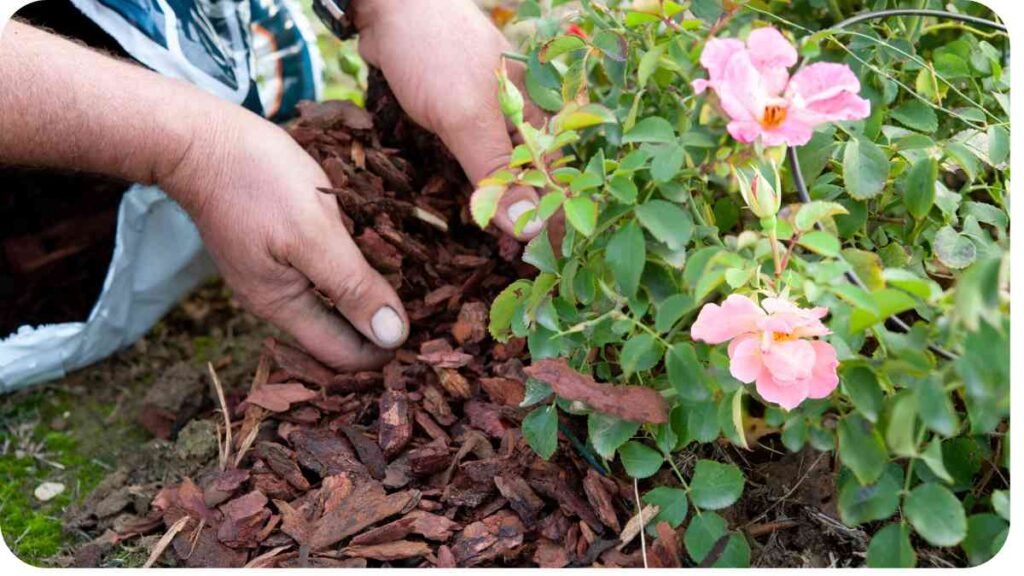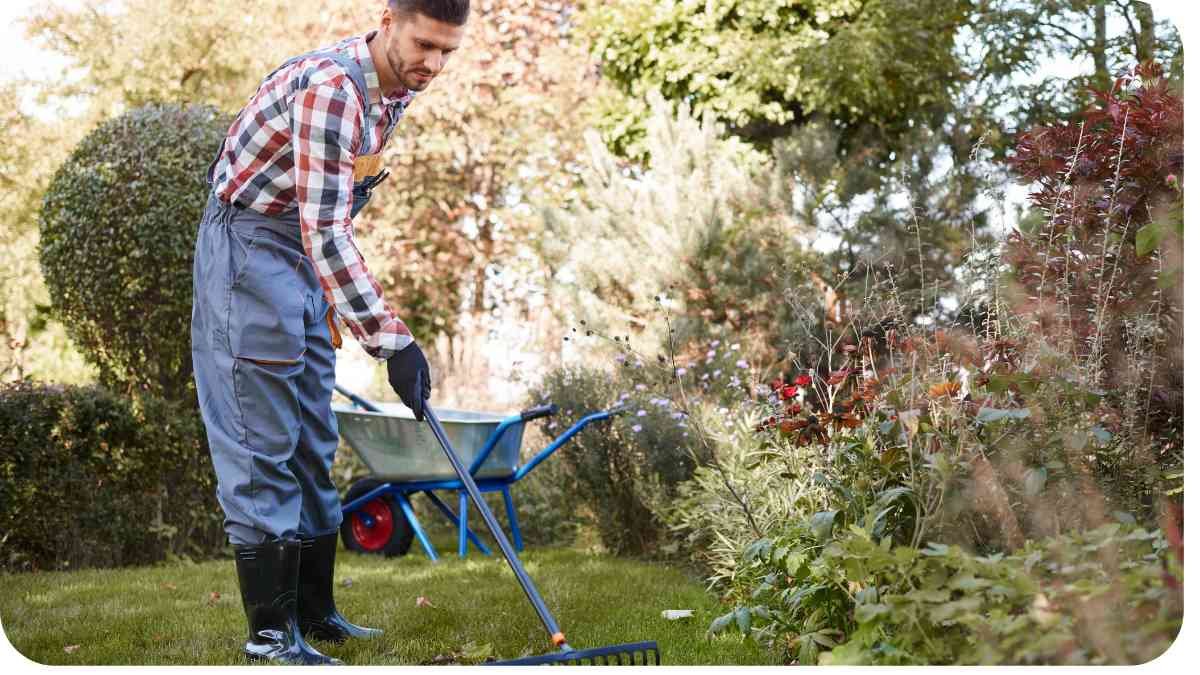As the vibrant hues of summer fade into the golden tones of autumn, it’s time to shift gears in your garden. Fall is a crucial transitional period where proper cleanup and preparation can set the stage for a thriving garden in the seasons ahead.
In this guide, we’ll explore the essential tasks you need to tackle to ensure your garden stays healthy and vibrant through the fall and into the winter months.
| Takeaways |
|---|
| 1. Conduct a soil test to assess nutrient levels and pH for targeted soil amendments. |
| 2. Remove summer debris to prevent pests and diseases from overwintering in the garden. |
| 3. Prune and trim shrubs, trees, and perennials to promote healthy growth in the upcoming seasons. |
| 4. Divide and transplant perennials to rejuvenate plants and create new additions to the garden. |
| 5. Amend soil with organic matter to improve soil structure and fertility for plant growth. |
| 6. Mulch garden beds to conserve moisture and provide insulation for plant roots. |
| 7. Protect tender plants from frost and freezing temperatures with appropriate measures. |
| 8. Clean and store garden tools properly to maintain their longevity and effectiveness. |
| 9. Inspect and prepare garden structures for winter weather to prolong their lifespan. |
| 10. Plant fall bulbs for vibrant spring blooms by following recommended planting guidelines. |
| 11. Compost fall debris to create nutrient-rich organic matter for garden soil enrichment. |
| 12. Plan ahead for spring by considering garden redesigns, new plantings, and crop rotations. |
2. Assessing Your Garden’s Needs

Before diving into fall cleanup, it’s essential to assess your garden’s current state and its specific requirements. One of the first steps is to conduct a soil test to determine its pH level and nutrient composition. This information will guide you in making necessary amendments to prepare your garden for the colder months.
Reviving a tired lawn after a challenging season is crucial for maintaining its lush appearance. Implementing restoration techniques such as overseeding and fertilization can breathe new life into your grass, ensuring it thrives in the upcoming months.
Soil Testing Table
| Soil Component | pH Level | Nutrient Composition |
|---|---|---|
| Nitrogen (N) | 6.5-7.0 | Adequate for plant growth |
| Phosphorus (P) | 6.0-7.5 | Moderate level, may require supplement |
| Potassium (K) | 5.5-6.5 | Low, needs significant supplementation |
3. Removing Summer Debris
Clearing out debris left over from the summer months is essential to prevent pests and diseases from overwintering in your garden. Take the time to remove dead leaves, spent flowers, and any diseased or pest-infested plant material. This not only tidies up your garden but also helps prevent the spread of pathogens.
Debris Removal Checklist
| Task | Description |
|---|---|
| Remove dead leaves | Rake up fallen leaves to prevent smothering of plants |
| Cut back spent flowers | Prune dead flowers to encourage new growth |
| Dispose of diseased plants | Remove and discard any plants showing signs of disease |
| Clean up debris | Clear out any other debris such as twigs and branches |
4. Pruning and Trimming
Fall is an excellent time to prune and trim shrubs, trees, and perennial plants to promote healthy growth in the coming seasons. Remove dead or diseased branches, shape shrubs for better structure, and cut back perennials to encourage strong root development.
Transitioning to a no-till garden approach offers numerous benefits for soil health and sustainability. Explore this comprehensive guide to learn how to create and maintain a thriving garden ecosystem without disturbing the soil structure.
Pruning Schedule Table
| Plant Type | Best Time for Pruning | Pruning Technique |
|---|---|---|
| Deciduous Trees | Late Fall to Early Winter | Remove dead or diseased branches |
| Evergreen Shrubs | Late Winter to Early Spring | Shape for desired structure |
| Perennials | Fall or Early Spring | Cut back to ground level |
.
5. Dividing and Transplanting Perennials
Fall is also an ideal time to divide and transplant perennials. Overgrown clumps of perennials can become crowded, leading to reduced flowering and overall plant health. Dividing them allows you to rejuvenate the plants and create new additions to your garden or share with friends.
Perennial Division Guide Table
| Perennial Plant | Best Time for Division | Division Technique |
|---|---|---|
| Hostas | Early Spring or Fall | Divide clumps using a sharp shovel |
| Daylilies | Fall | Lift clumps and separate rhizomes |
| Irises | Summer or Fall | Divide rhizomes with a knife |
6. Amending Soil
After assessing your soil’s nutrient levels, it’s time to amend it as needed to ensure optimal growing conditions for your plants. Incorporate organic matter such as compost, well-rotted manure, or leaf mold to improve soil structure and fertility.
Soil Amendment Guide Table
| Soil Condition | Recommended Amendment | Application Rate |
|---|---|---|
| Sandy soil | Compost or well-rotted manure | 2-3 inches per square foot |
| Clay soil | Compost or leaf mold | 3-4 inches per square foot |
| Acidic soil | Lime | Follow package instructions |
7. Mulching for Winter Protection

Mulching is a crucial step in preparing your garden for winter. Not only does mulch help conserve soil moisture and suppress weeds, but it also provides insulation to protect plant roots from freezing temperatures.
Elevate your gardening experience with raised beds, ideal for optimizing space and drainage. Discover how to enhance your harvest and create a manageable garden layout, perfect for fall planting and long-term garden management.
Mulch Types Comparison Table
| Mulch Material | Pros | Cons |
|---|---|---|
| Organic (e.g., | – Adds nutrients to soil as it | – Requires replenishment |
| compost, leaves) | decomposes | – Attracts pests if not |
| – Improves soil structure | properly managed | |
| Inorganic (e.g., | – Long-lasting | – Doesn’t contribute to soil |
| gravel, | – Effective at weed suppression | fertility |
| landscape fabric) | – Doesn’t decompose | – May interfere with water |
| penetration |
8. Protecting Tender Plants
As temperatures drop, it’s crucial to protect tender plants from frost and freezing conditions. Whether using frost blankets, cloches, or simply moving potted plants indoors, taking proactive measures can prevent damage and extend the growing season.
Frost Protection Methods Table
| Plant Type | Protection Method | Duration |
|---|---|---|
| Annual Flowers | Frost blankets or row covers | Overnight |
| Tender Shrubs | Mulch or burlap wraps | Throughout the winter |
| Potted Plants | Move indoors or into a shelter | During frost warnings |
9. Cleaning and Storing Garden Tools
Proper maintenance of garden tools is essential to ensure their longevity and effectiveness. Take the time to clean, sharpen, and properly store your tools to prevent rust and damage during the offseason.
Attracting pollinators to your garden is essential for promoting biodiversity and plant health. Explore this guide to discover perennial flowers that will entice bees and butterflies, ensuring your garden remains vibrant and productive year-round.
Tool Cleaning Checklist
| Tool | Cleaning Steps | Storage Tips |
|---|---|---|
| Pruners | – Wipe blades with a disinfectant solution | – Store in a dry location |
| Shovels | – Remove dirt and debris from the blade | – Hang on a pegboard or rack |
| Garden Trowel | – Scrub with a wire brush to remove soil | – Keep in a tool caddy or box |
| Rakes | – Remove debris from tines with a brush | – Hang vertically to prevent bending |
10. Preparing Garden Structures
Inspecting and preparing garden structures such as trellises, arbors, and fences is essential to ensure they withstand winter weather conditions. Repair any damage and apply protective coatings as needed to prolong their lifespan.
Structure Inspection Checklist
| Structure | Inspection Steps | Maintenance Tasks |
|---|---|---|
| Trellis | Check for loose or damaged parts | Tighten screws or replace parts |
| Arbors | Inspect for rot or insect damage | Sand and apply a protective sealant |
| Fences | Look for signs of leaning or sagging | Reinforce with additional supports |
11. Planting Fall Bulbs
Fall is the perfect time to plant bulbs for spring blooms. Whether you prefer tulips, daffodils, or crocuses, planting bulbs in the fall allows them to establish roots before the ground freezes, resulting in beautiful displays of color once spring arrives.
Bulb Planting Guide Table
| Bulb Type | Planting Depth | Spacing | Best Time to Plant |
|---|---|---|---|
| Tulips | 6-8 inches | 4-6 inches | Late September to |
| Early November | |||
| Daffodils | 6-8 inches | 4-6 inches | September to November |
| Crocuses | 3-4 inches | 2-3 inches | September to October |
12. Planning for Spring
While fall is a time for cleanup and preparation, it’s also an opportunity to plan ahead for the spring season. Take note of areas in your garden that may need redesigning or new plantings, and start researching plant varieties and garden layouts to implement once the warmer weather returns.
Spring Planting Schedule Table
| Plant Type | Starting Seeds Indoors | Direct Sowing in Garden | Transplanting Outdoors |
|---|---|---|---|
| Tomatoes | 6-8 weeks before | After last frost date | After last frost date |
| last frost date | |||
| Peppers | 8-10 weeks before | After last frost date | After last frost date |
| last frost date | |||
| Annual Flowers | 6-8 weeks before | After last frost date | After last frost date |
| last frost date |
13. Composting Fall Debris
Instead of disposing of fall debris, consider composting it to create nutrient-rich organic matter for your garden. Leaves, grass clippings, and other plant material can be composted to produce a valuable soil amendment that improves soil structure and fertility.
Attracting pollinators to your garden is essential for promoting biodiversity and plant health. Explore this guide to discover perennial flowers that will entice bees and butterflies, ensuring your garden remains vibrant and productive year-round.
Composting Guide Table
| Composting Material | Suitable Items | Avoid |
|---|---|---|
| Leaves | Dry leaves, shredded paper | Diseased or pest-infested plants |
| Grass clippings | Fresh grass clippings | Weeds with mature seeds |
| Vegetable scraps | Fruit and vegetable peels, coffee grounds | Meat, dairy, or oily foods |
C: This table outlines suitable materials for composting and items to avoid, helping readers create compost piles that produce high-quality organic matter.
14. Conclusion
Transitioning your garden for fall is a crucial step in maintaining its health and vitality throughout the changing seasons. By completing essential cleanup and preparation tasks, you set the stage for a successful growing season ahead. Remember to assess your garden’s needs, prioritize tasks, and plan for both the immediate and future needs of your garden.
Further Reading
Here are some additional resources to explore for further guidance on fall garden cleanup and preparation:
- Vego Garden: Transitioning to Fall Gardening – Offers comprehensive advice on essential tasks for cooler weather gardening.
- Epic Gardening: Skipping Fall Cleanup – Discusses the benefits of skipping fall cleanup and its impact on garden health.
- Red Bud Landscape: Tips on Fall Garden Cleanup – Provides practical tips and insights for effective fall garden cleanup.
FAQs
How do I know when it’s time to transition my garden for fall?
Fall transition typically begins when temperatures start to cool down, usually in late summer or early fall. Look for signs such as shorter daylight hours and declining temperatures to gauge when to start preparing your garden for the season ahead.
Should I remove all the debris from my garden in the fall?
While removing some debris is essential to prevent pests and diseases, leaving some organic matter can provide habitat for beneficial insects and organisms. Consider leaving a layer of leaves as mulch or creating compost piles with fall debris.
Can I prune trees and shrubs in the fall?
Fall is generally a suitable time for pruning trees and shrubs, especially deciduous varieties. However, it’s best to avoid heavy pruning late in the fall to prevent stimulating new growth that may be damaged by frost.
What should I do with my garden tools after fall cleanup?
After cleaning your garden tools, it’s important to store them properly to prevent rust and damage. Keep them in a dry, sheltered location such as a shed or garage, and consider applying a light coat of oil to metal parts for added protection.
Is fall a good time to plant bulbs for spring blooms?
Yes, fall is an ideal time to plant bulbs such as tulips, daffodils, and crocuses. Planting them in the fall allows them to establish roots before the ground freezes, ensuring beautiful blooms once spring arrives.

Hellen James, a seasoned author at Unified Publishers LLC, brings a wealth of expertise to diverse niches. Specializing in pet care, outdoor adventures, lifestyle, wellness, and culinary delights, Hellen crafts insightful and engaging content that unlocks the full potential of readers’ interests. Explore, learn, and thrive with Hellen James.

